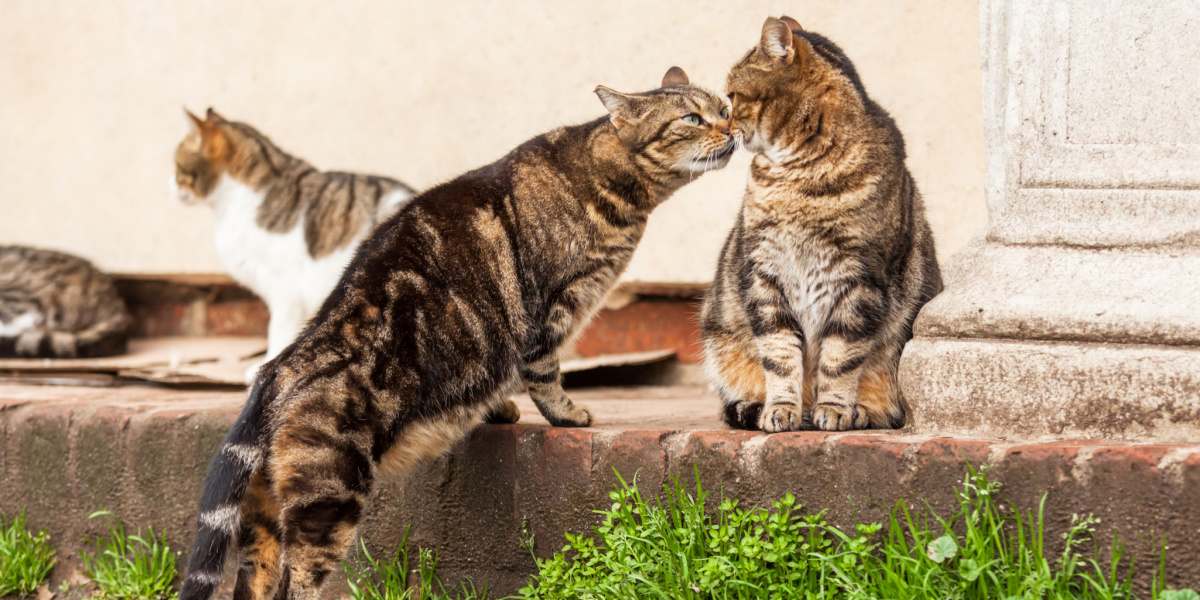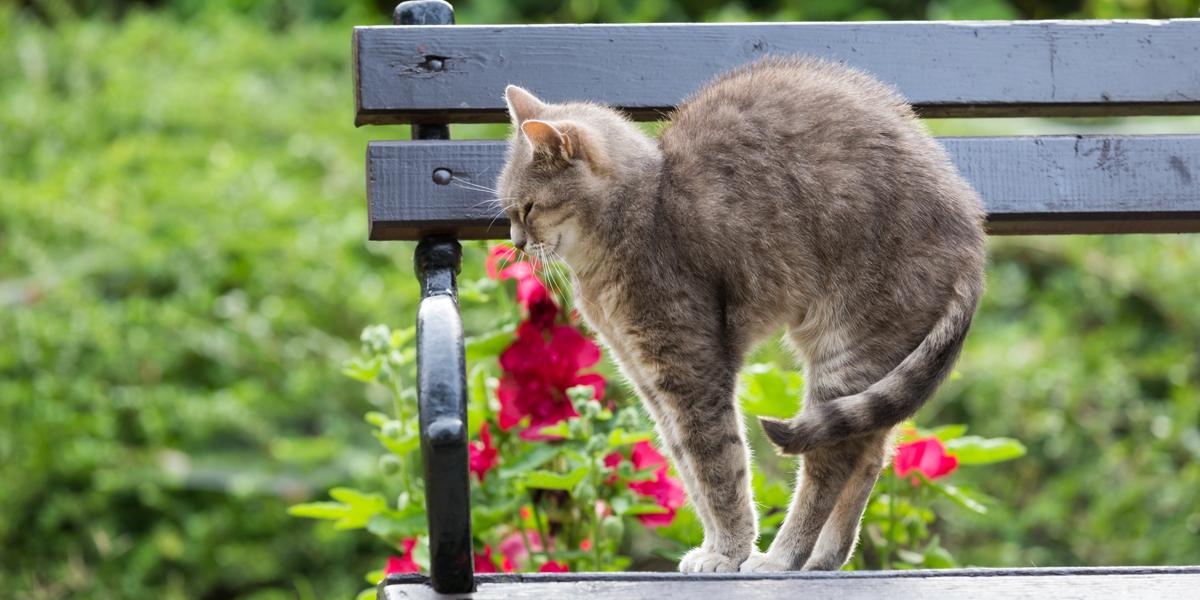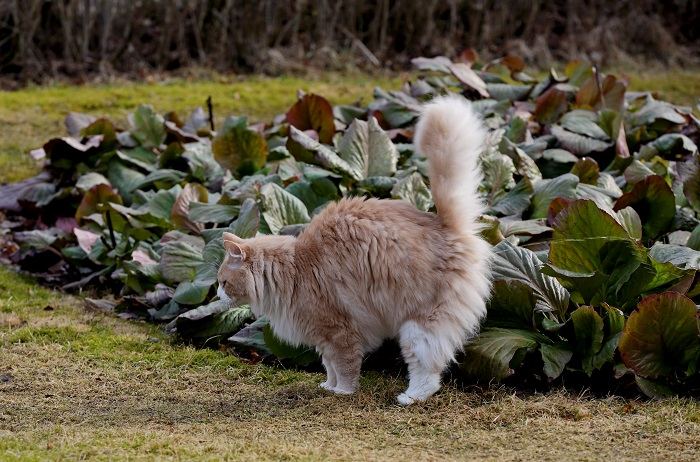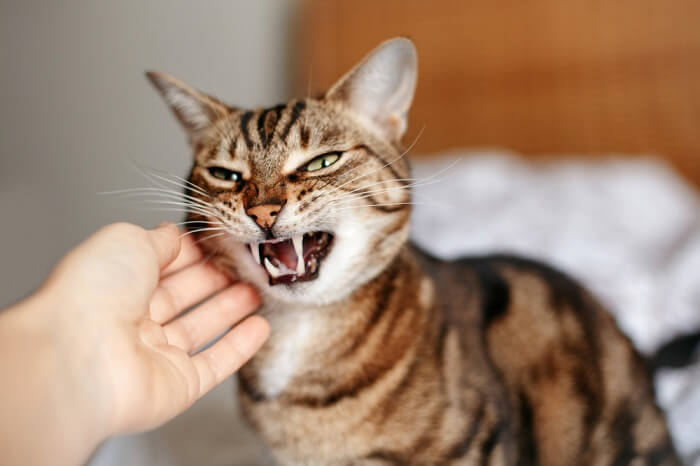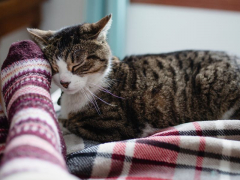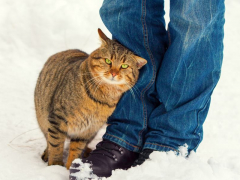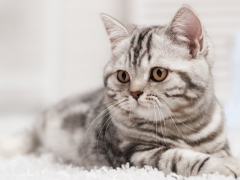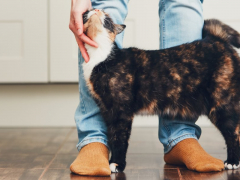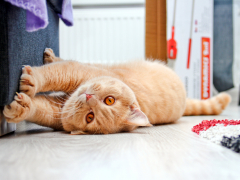The study of cat behavior is fascinating for many reasons, but the question of how cats communicate with each other is of huge interest to both pet parents and veterinarians.
As both a cat owner and a veterinarian with a special interest in animal behavior, I have worked with and owned, cats for many years, and I am still always learning new things about feline communication.
Cat communication is multi-layered, using vocalization, body language, physical contact, and scent. Some cat language is subtle (did you see that blink?), and some not so much—the hissing and yowling of a cat fight come to mind!
Like most things with cats, there is always more to it than meets the eye. So read on if you want to find out more about the intricate language of our domestic cats, from kittens to adult cats.
Visual Cues
Visual signaling is an important part of feline communication. Physically aggressive behavior is rarely seen without a lot of escalation first, starting with preliminary visual cues such as changes to body posture, facial expressions, and the ability to erect hair over the body.
1. Tail Position
Your cat’s tail often gives a lot away about mood. If their tail is upright and tall when approaching another cat (or human), this is generally a friendly and approachable sign. A quivering upright tail is even better and indicates pleasure when greeting.
In contrast, a tail up but puffed out with erect hairs signals aggression, as does a tail that lashes from side to side. If the tail tucks down between the back legs, your cat is indicating submission or nervousness. A half-raised tail indicates curiosity.
2. Facial Expressions
Differing positions of the eyes, ears, and mouth are also forms of communication for cats. Narrowed pupils, fanned-out whiskers, and erect ears rotated outward are signs of aggression, whereas dilated pupils, bunched whiskers, and ears flattened against the head is a sign of a fearful cat.
Eye contact is also important. A cat holding a direct stare with no blinking is a definite challenge, whereas relaxed eye contact with slow blinks indicates contentment and love.
3. Postures
Some cats arch their backs to stretch, but this position can also indicate aggression or defensiveness.
Your cat may use their entire body to indicate various moods. An arched back can indicate aggression or defensiveness, and cats cringing close to the ground with thumping tail is also very defensive.
If your cat is a hunter, you may note the classic “hunting crouch” with your cat’s body stretched out long, ready to pounce. Cats rolling onto their backs is thought to be friendly or submissive.
Tactile Communication
Cats can be solitary creatures, but when in social groups there are a variety of methods of physical contact. Bonded cats often sleep curled up together, using each other as a pillow. In fact, this is called “pillowing.”
Allogrooming, where two cats groom each other, is also a common behavior, as is allorubbing, where two cats rub their faces and bodies together. These behaviors are likely also involved in scent transfer and olfactory communication to strengthen social bonds. You may also see cats backing up toward each other and twining their tails, which is thought to be a form of social communication.
Scent Cues
Scent is a hugely important method of communicating between cats. Feline species generally have an excellent sense of smell, and they also have a vomeronasal organ, which can process pheromone communication—a form of chemical messaging.
1. Pheromones
If you see your cat “tasting” the air, with their face contracted into a grimace, they are likely smelling chemical messages called pheromones, using the vomeronasal organ on the roof of their mouth. These chemical scent messages are important as they can give very specific messages, and last a long time in the environment.
Pheromones can communicate a whole host of things, including territory marking, greetings, sexual availability, and warnings, and can also identify “safe” areas and individuals. Cats use scent glands on their cheeks, chins, and foreheads to leave these scent markings as a form of a message to both themselves and other cats.
2. Urine and Feces
Any cat can spray, but male cats that are not neutered are more likely to urine spray.
Cats also leave scent markings via urine spraying, conveying messages about territory, other cats, and sexual partners. Intact males are most likely to urine spray, but all cats can perform this behavior. The role of feces in communication is less clear, but it is noted that when cats defecate inside their territory, they tend to bury it; they leave the poo uncovered if it is near a territory boundary.
Vocal Communications
There is a large range of cat vocalizations—more so generally than is observed in other carnivores. Vocal sounds are often seen in cat-human interactions, such as meowing for food or purring when petted, but cats also communicate vocally with each other. Some breeds of cats, such as the Siamese, are known for their chatter and have an extensive range of vocal sounds.
1. The Meow
The classic cat meow sound is usually only found in cat-to-cat communication between kittens and their mothers. A study in Sweden found that adult cats only meow to humans, and not to other cats.
2. Purrs
Murmuring sounds like the purr and the greeting trill usually indicate contentment and friendliness. Kittens and their mothers often purr whilst the kitten is nursing, and adults purr when grooming each other. Some cats will purr, trill, or chirrup as a greeting to both humans and other cats.
3. Aggressive Sounds
Aggressive vocalizations in cats are often pretty simply to understand.
Vocalizations made with the mouth held open indicate aggression: a growl, howl, snarl, or whine. These can be either offensive or defensive, and if not successful in de-escalating conflict cats may progress to spit or wail at their opponent before physical fighting begins with claws and teeth.
4. Predatory Sounds
Cats have a specific chatter sound that they use when they spot prey, such as a bird or small mammal. They may also squeak in excitement. This is a common sound to hear if you have a cat who likes to watch out of the windows.
Final Thoughts
Well, did you ever realize that cat communication is so complicated? It’s not just a meow here and there, cats have an extensive range of ways to communicate, from the subtle to the more obvious.
Posture, facial expression, scent, and touch are just as important as the more vocal cues. Next time your cat is interacting with another cat, watch and see if you can spot any of these clever methods of communicating!
Also Read: 7 Reasons Your Cat Is Yowling And How To Help!
Frequently Asked Questions
How do cats communicate with other cats?
Cats use a variety of communication methods: vocal, tactile, visual, and scent. These categories include scent and pheromones, body position and posture, facial expression, grooming and rubbing behaviors, and vocal sounds.
Do cats understand when they meow at each other?
The meow is actually a sound only heard between kittens and mother cats. In adult cats, the meow has been found to only be directed at humans rather than other cats.
Do cats silently communicate with each other?
Yes, definitely. Vocal noises are only a small part of cat communication. Cats are exchanging messages all the time, through their posture and facial expression (even blinking!), scent messages, and even through grooming or rubbing against each other.
Can cats tell each other things?
Yes, their vocalizations and postures can indicate their mood, but the use of scent messages is more complex and can tell each other about their sexual availability, their territory, and about other cats.
